How Fast Fashion Intensifies Climate Change: A Detailed Study
VerifiedAdded on 2023/06/11
|7
|1437
|451
Essay
AI Summary
This essay explores the significant contribution of the fast fashion industry to climate change, highlighting its role in air, water, and soil pollution. It discusses how the demand for cheap and rapidly changing clothing trends, fueled by a growing population and online shopping, has led to increased production and waste. The essay also touches upon initiatives like the 'Fashion Industry Charter for Climate Action' and emphasizes the need for a shift towards slow fashion to mitigate the environmental damage. It further explains the impact of textile waste, the concept of micro-seasons in fashion, and the throwaway culture associated with fast fashion, which collectively contribute to the alarming levels of pollution and the existence of massive garbage patches in our oceans. The report concludes by emphasizing the responsibility of both producers and consumers in adopting sustainable practices to reduce the devastating effects of fast fashion on the global climate.
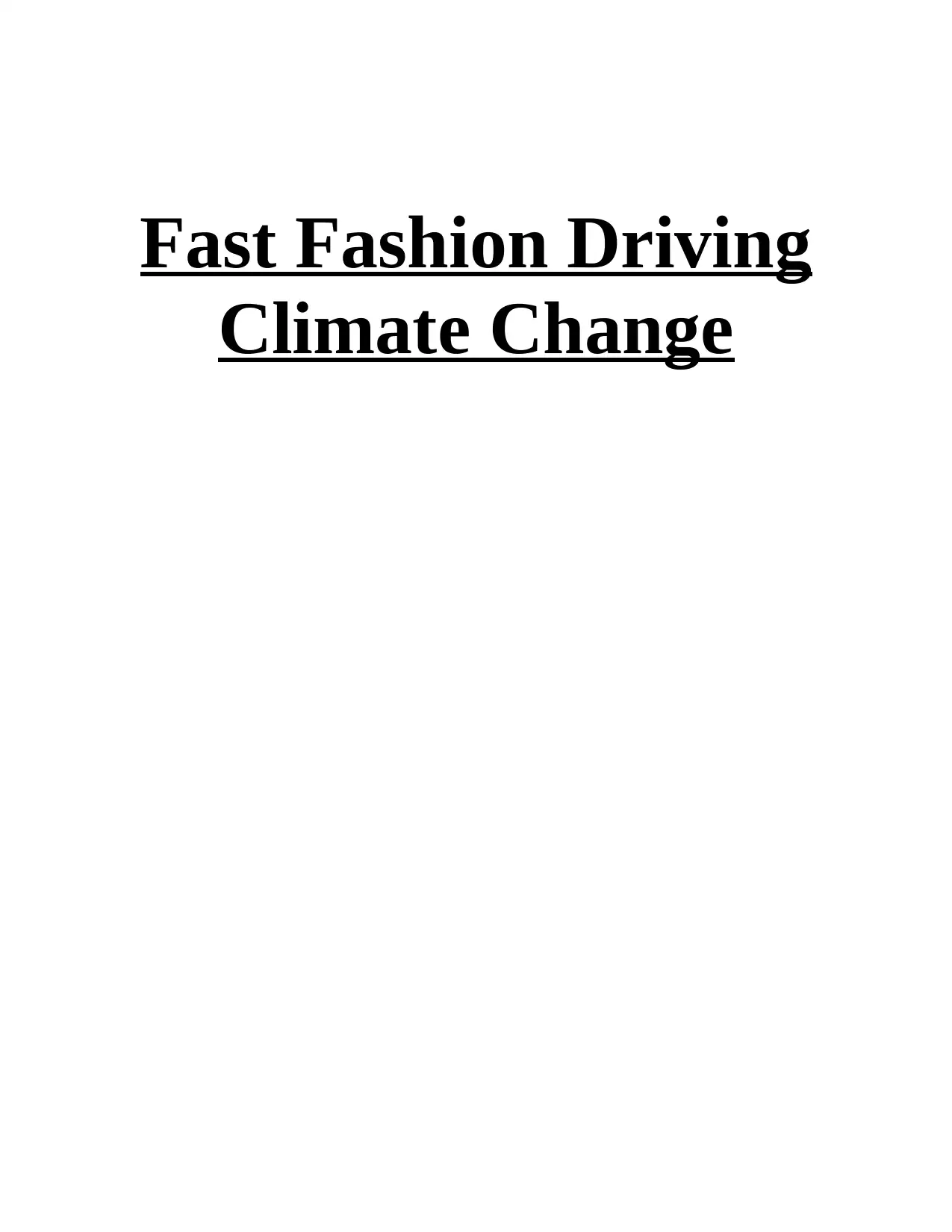
Fast Fashion Driving
Climate Change
Climate Change
Paraphrase This Document
Need a fresh take? Get an instant paraphrase of this document with our AI Paraphraser

Table of Contents
INTRODUCTION...........................................................................................................................1
MAIN BODY...................................................................................................................................1
CONCLUSION................................................................................................................................3
REFERENCES................................................................................................................................4
INTRODUCTION...........................................................................................................................1
MAIN BODY...................................................................................................................................1
CONCLUSION................................................................................................................................3
REFERENCES................................................................................................................................4
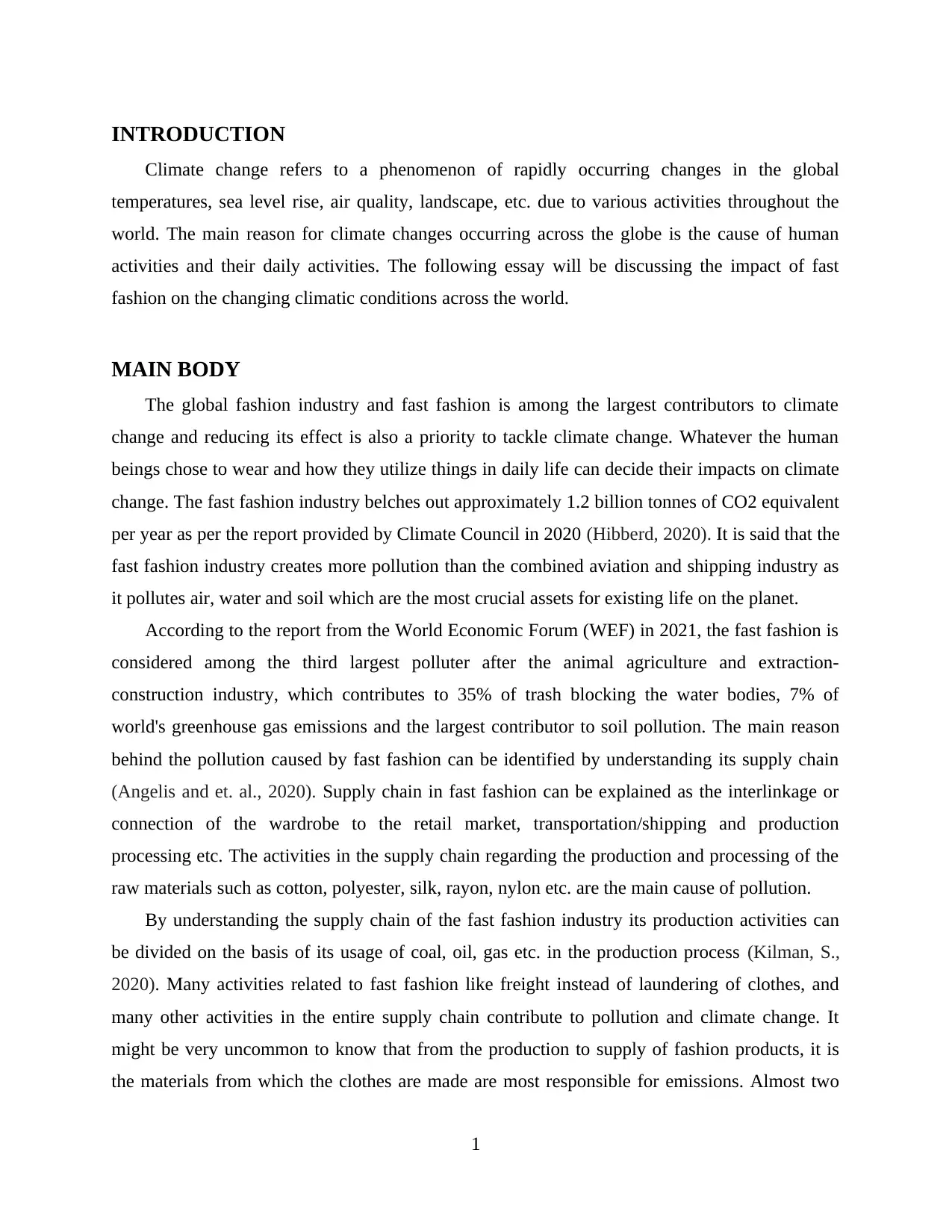
INTRODUCTION
Climate change refers to a phenomenon of rapidly occurring changes in the global
temperatures, sea level rise, air quality, landscape, etc. due to various activities throughout the
world. The main reason for climate changes occurring across the globe is the cause of human
activities and their daily activities. The following essay will be discussing the impact of fast
fashion on the changing climatic conditions across the world.
MAIN BODY
The global fashion industry and fast fashion is among the largest contributors to climate
change and reducing its effect is also a priority to tackle climate change. Whatever the human
beings chose to wear and how they utilize things in daily life can decide their impacts on climate
change. The fast fashion industry belches out approximately 1.2 billion tonnes of CO2 equivalent
per year as per the report provided by Climate Council in 2020 (Hibberd, 2020). It is said that the
fast fashion industry creates more pollution than the combined aviation and shipping industry as
it pollutes air, water and soil which are the most crucial assets for existing life on the planet.
According to the report from the World Economic Forum (WEF) in 2021, the fast fashion is
considered among the third largest polluter after the animal agriculture and extraction-
construction industry, which contributes to 35% of trash blocking the water bodies, 7% of
world's greenhouse gas emissions and the largest contributor to soil pollution. The main reason
behind the pollution caused by fast fashion can be identified by understanding its supply chain
(Angelis and et. al., 2020). Supply chain in fast fashion can be explained as the interlinkage or
connection of the wardrobe to the retail market, transportation/shipping and production
processing etc. The activities in the supply chain regarding the production and processing of the
raw materials such as cotton, polyester, silk, rayon, nylon etc. are the main cause of pollution.
By understanding the supply chain of the fast fashion industry its production activities can
be divided on the basis of its usage of coal, oil, gas etc. in the production process (Kilman, S.,
2020). Many activities related to fast fashion like freight instead of laundering of clothes, and
many other activities in the entire supply chain contribute to pollution and climate change. It
might be very uncommon to know that from the production to supply of fashion products, it is
the materials from which the clothes are made are most responsible for emissions. Almost two
1
Climate change refers to a phenomenon of rapidly occurring changes in the global
temperatures, sea level rise, air quality, landscape, etc. due to various activities throughout the
world. The main reason for climate changes occurring across the globe is the cause of human
activities and their daily activities. The following essay will be discussing the impact of fast
fashion on the changing climatic conditions across the world.
MAIN BODY
The global fashion industry and fast fashion is among the largest contributors to climate
change and reducing its effect is also a priority to tackle climate change. Whatever the human
beings chose to wear and how they utilize things in daily life can decide their impacts on climate
change. The fast fashion industry belches out approximately 1.2 billion tonnes of CO2 equivalent
per year as per the report provided by Climate Council in 2020 (Hibberd, 2020). It is said that the
fast fashion industry creates more pollution than the combined aviation and shipping industry as
it pollutes air, water and soil which are the most crucial assets for existing life on the planet.
According to the report from the World Economic Forum (WEF) in 2021, the fast fashion is
considered among the third largest polluter after the animal agriculture and extraction-
construction industry, which contributes to 35% of trash blocking the water bodies, 7% of
world's greenhouse gas emissions and the largest contributor to soil pollution. The main reason
behind the pollution caused by fast fashion can be identified by understanding its supply chain
(Angelis and et. al., 2020). Supply chain in fast fashion can be explained as the interlinkage or
connection of the wardrobe to the retail market, transportation/shipping and production
processing etc. The activities in the supply chain regarding the production and processing of the
raw materials such as cotton, polyester, silk, rayon, nylon etc. are the main cause of pollution.
By understanding the supply chain of the fast fashion industry its production activities can
be divided on the basis of its usage of coal, oil, gas etc. in the production process (Kilman, S.,
2020). Many activities related to fast fashion like freight instead of laundering of clothes, and
many other activities in the entire supply chain contribute to pollution and climate change. It
might be very uncommon to know that from the production to supply of fashion products, it is
the materials from which the clothes are made are most responsible for emissions. Almost two
1
⊘ This is a preview!⊘
Do you want full access?
Subscribe today to unlock all pages.

Trusted by 1+ million students worldwide
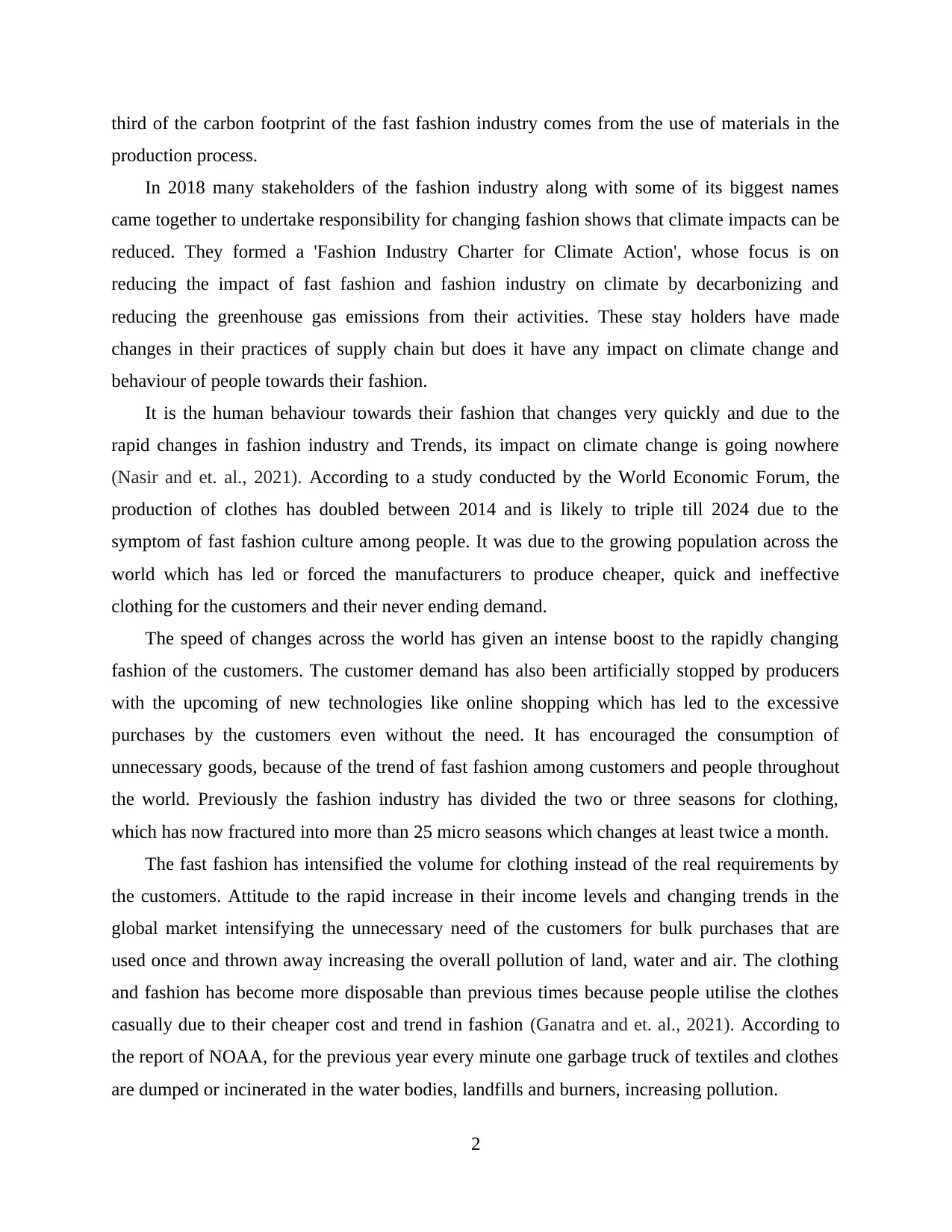
third of the carbon footprint of the fast fashion industry comes from the use of materials in the
production process.
In 2018 many stakeholders of the fashion industry along with some of its biggest names
came together to undertake responsibility for changing fashion shows that climate impacts can be
reduced. They formed a 'Fashion Industry Charter for Climate Action', whose focus is on
reducing the impact of fast fashion and fashion industry on climate by decarbonizing and
reducing the greenhouse gas emissions from their activities. These stay holders have made
changes in their practices of supply chain but does it have any impact on climate change and
behaviour of people towards their fashion.
It is the human behaviour towards their fashion that changes very quickly and due to the
rapid changes in fashion industry and Trends, its impact on climate change is going nowhere
(Nasir and et. al., 2021). According to a study conducted by the World Economic Forum, the
production of clothes has doubled between 2014 and is likely to triple till 2024 due to the
symptom of fast fashion culture among people. It was due to the growing population across the
world which has led or forced the manufacturers to produce cheaper, quick and ineffective
clothing for the customers and their never ending demand.
The speed of changes across the world has given an intense boost to the rapidly changing
fashion of the customers. The customer demand has also been artificially stopped by producers
with the upcoming of new technologies like online shopping which has led to the excessive
purchases by the customers even without the need. It has encouraged the consumption of
unnecessary goods, because of the trend of fast fashion among customers and people throughout
the world. Previously the fashion industry has divided the two or three seasons for clothing,
which has now fractured into more than 25 micro seasons which changes at least twice a month.
The fast fashion has intensified the volume for clothing instead of the real requirements by
the customers. Attitude to the rapid increase in their income levels and changing trends in the
global market intensifying the unnecessary need of the customers for bulk purchases that are
used once and thrown away increasing the overall pollution of land, water and air. The clothing
and fashion has become more disposable than previous times because people utilise the clothes
casually due to their cheaper cost and trend in fashion (Ganatra and et. al., 2021). According to
the report of NOAA, for the previous year every minute one garbage truck of textiles and clothes
are dumped or incinerated in the water bodies, landfills and burners, increasing pollution.
2
production process.
In 2018 many stakeholders of the fashion industry along with some of its biggest names
came together to undertake responsibility for changing fashion shows that climate impacts can be
reduced. They formed a 'Fashion Industry Charter for Climate Action', whose focus is on
reducing the impact of fast fashion and fashion industry on climate by decarbonizing and
reducing the greenhouse gas emissions from their activities. These stay holders have made
changes in their practices of supply chain but does it have any impact on climate change and
behaviour of people towards their fashion.
It is the human behaviour towards their fashion that changes very quickly and due to the
rapid changes in fashion industry and Trends, its impact on climate change is going nowhere
(Nasir and et. al., 2021). According to a study conducted by the World Economic Forum, the
production of clothes has doubled between 2014 and is likely to triple till 2024 due to the
symptom of fast fashion culture among people. It was due to the growing population across the
world which has led or forced the manufacturers to produce cheaper, quick and ineffective
clothing for the customers and their never ending demand.
The speed of changes across the world has given an intense boost to the rapidly changing
fashion of the customers. The customer demand has also been artificially stopped by producers
with the upcoming of new technologies like online shopping which has led to the excessive
purchases by the customers even without the need. It has encouraged the consumption of
unnecessary goods, because of the trend of fast fashion among customers and people throughout
the world. Previously the fashion industry has divided the two or three seasons for clothing,
which has now fractured into more than 25 micro seasons which changes at least twice a month.
The fast fashion has intensified the volume for clothing instead of the real requirements by
the customers. Attitude to the rapid increase in their income levels and changing trends in the
global market intensifying the unnecessary need of the customers for bulk purchases that are
used once and thrown away increasing the overall pollution of land, water and air. The clothing
and fashion has become more disposable than previous times because people utilise the clothes
casually due to their cheaper cost and trend in fashion (Ganatra and et. al., 2021). According to
the report of NOAA, for the previous year every minute one garbage truck of textiles and clothes
are dumped or incinerated in the water bodies, landfills and burners, increasing pollution.
2
Paraphrase This Document
Need a fresh take? Get an instant paraphrase of this document with our AI Paraphraser
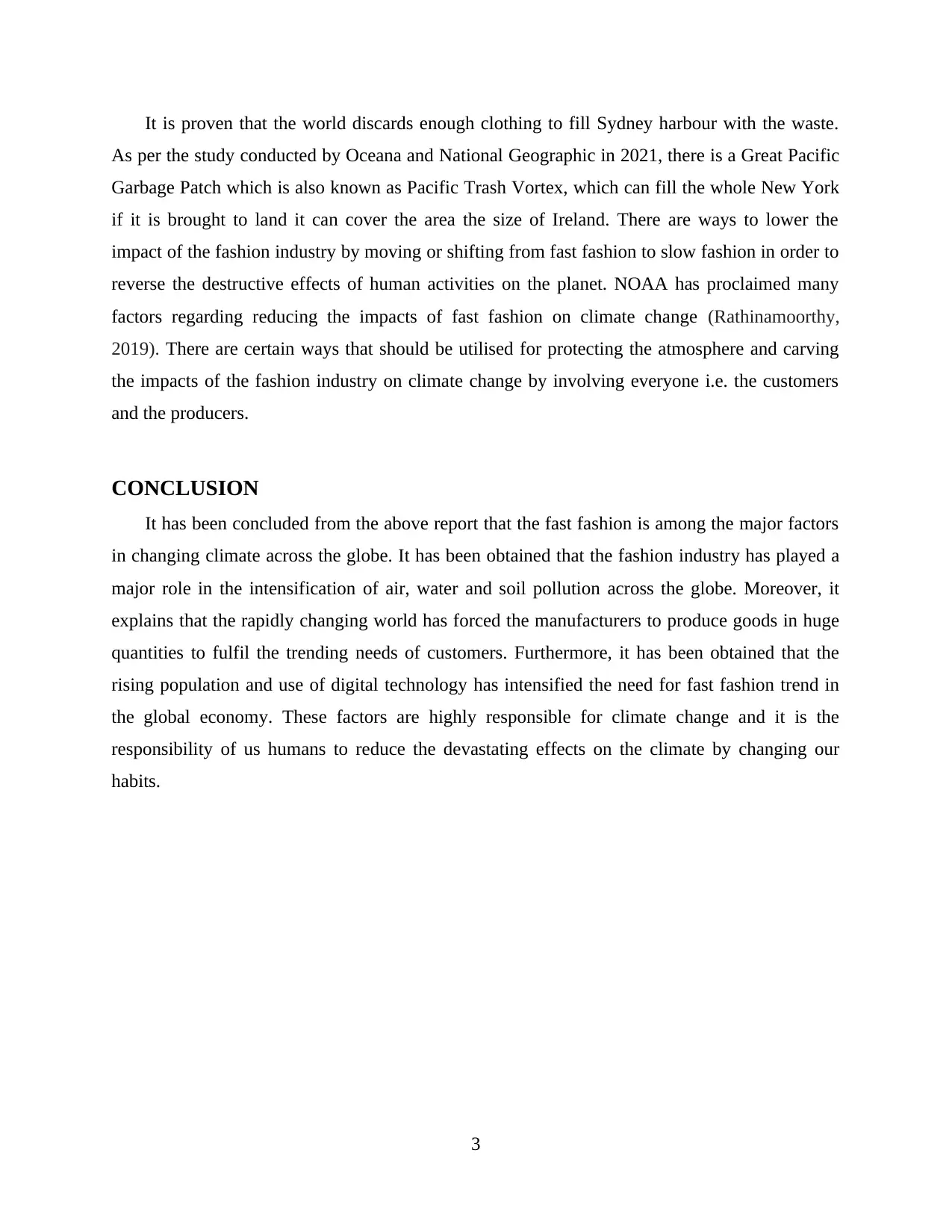
It is proven that the world discards enough clothing to fill Sydney harbour with the waste.
As per the study conducted by Oceana and National Geographic in 2021, there is a Great Pacific
Garbage Patch which is also known as Pacific Trash Vortex, which can fill the whole New York
if it is brought to land it can cover the area the size of Ireland. There are ways to lower the
impact of the fashion industry by moving or shifting from fast fashion to slow fashion in order to
reverse the destructive effects of human activities on the planet. NOAA has proclaimed many
factors regarding reducing the impacts of fast fashion on climate change (Rathinamoorthy,
2019). There are certain ways that should be utilised for protecting the atmosphere and carving
the impacts of the fashion industry on climate change by involving everyone i.e. the customers
and the producers.
CONCLUSION
It has been concluded from the above report that the fast fashion is among the major factors
in changing climate across the globe. It has been obtained that the fashion industry has played a
major role in the intensification of air, water and soil pollution across the globe. Moreover, it
explains that the rapidly changing world has forced the manufacturers to produce goods in huge
quantities to fulfil the trending needs of customers. Furthermore, it has been obtained that the
rising population and use of digital technology has intensified the need for fast fashion trend in
the global economy. These factors are highly responsible for climate change and it is the
responsibility of us humans to reduce the devastating effects on the climate by changing our
habits.
3
As per the study conducted by Oceana and National Geographic in 2021, there is a Great Pacific
Garbage Patch which is also known as Pacific Trash Vortex, which can fill the whole New York
if it is brought to land it can cover the area the size of Ireland. There are ways to lower the
impact of the fashion industry by moving or shifting from fast fashion to slow fashion in order to
reverse the destructive effects of human activities on the planet. NOAA has proclaimed many
factors regarding reducing the impacts of fast fashion on climate change (Rathinamoorthy,
2019). There are certain ways that should be utilised for protecting the atmosphere and carving
the impacts of the fashion industry on climate change by involving everyone i.e. the customers
and the producers.
CONCLUSION
It has been concluded from the above report that the fast fashion is among the major factors
in changing climate across the globe. It has been obtained that the fashion industry has played a
major role in the intensification of air, water and soil pollution across the globe. Moreover, it
explains that the rapidly changing world has forced the manufacturers to produce goods in huge
quantities to fulfil the trending needs of customers. Furthermore, it has been obtained that the
rising population and use of digital technology has intensified the need for fast fashion trend in
the global economy. These factors are highly responsible for climate change and it is the
responsibility of us humans to reduce the devastating effects on the climate by changing our
habits.
3
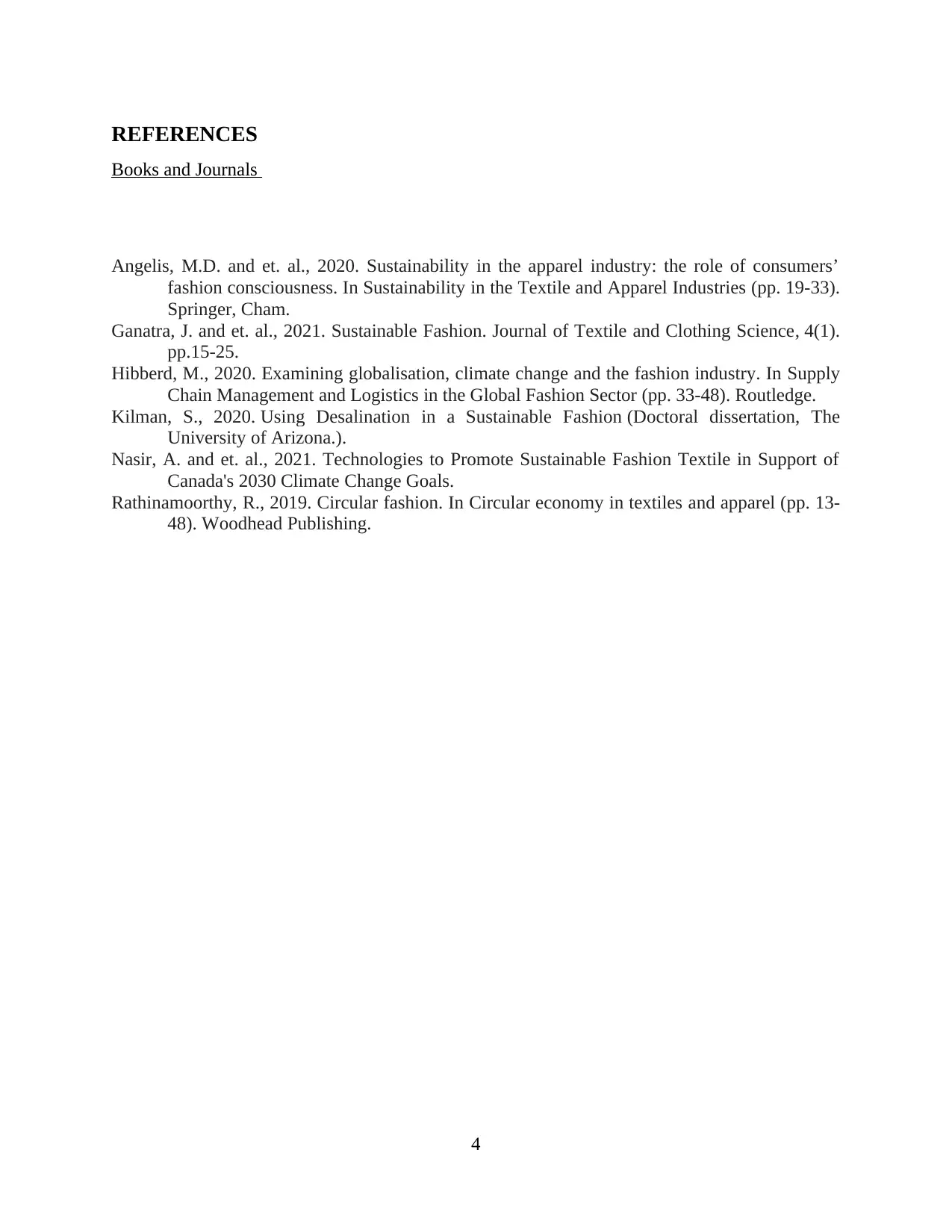
REFERENCES
Books and Journals
Angelis, M.D. and et. al., 2020. Sustainability in the apparel industry: the role of consumers’
fashion consciousness. In Sustainability in the Textile and Apparel Industries (pp. 19-33).
Springer, Cham.
Ganatra, J. and et. al., 2021. Sustainable Fashion. Journal of Textile and Clothing Science, 4(1).
pp.15-25.
Hibberd, M., 2020. Examining globalisation, climate change and the fashion industry. In Supply
Chain Management and Logistics in the Global Fashion Sector (pp. 33-48). Routledge.
Kilman, S., 2020. Using Desalination in a Sustainable Fashion (Doctoral dissertation, The
University of Arizona.).
Nasir, A. and et. al., 2021. Technologies to Promote Sustainable Fashion Textile in Support of
Canada's 2030 Climate Change Goals.
Rathinamoorthy, R., 2019. Circular fashion. In Circular economy in textiles and apparel (pp. 13-
48). Woodhead Publishing.
4
Books and Journals
Angelis, M.D. and et. al., 2020. Sustainability in the apparel industry: the role of consumers’
fashion consciousness. In Sustainability in the Textile and Apparel Industries (pp. 19-33).
Springer, Cham.
Ganatra, J. and et. al., 2021. Sustainable Fashion. Journal of Textile and Clothing Science, 4(1).
pp.15-25.
Hibberd, M., 2020. Examining globalisation, climate change and the fashion industry. In Supply
Chain Management and Logistics in the Global Fashion Sector (pp. 33-48). Routledge.
Kilman, S., 2020. Using Desalination in a Sustainable Fashion (Doctoral dissertation, The
University of Arizona.).
Nasir, A. and et. al., 2021. Technologies to Promote Sustainable Fashion Textile in Support of
Canada's 2030 Climate Change Goals.
Rathinamoorthy, R., 2019. Circular fashion. In Circular economy in textiles and apparel (pp. 13-
48). Woodhead Publishing.
4
⊘ This is a preview!⊘
Do you want full access?
Subscribe today to unlock all pages.

Trusted by 1+ million students worldwide

5
1 out of 7
Related Documents
Your All-in-One AI-Powered Toolkit for Academic Success.
+13062052269
info@desklib.com
Available 24*7 on WhatsApp / Email
![[object Object]](/_next/static/media/star-bottom.7253800d.svg)
Unlock your academic potential
Copyright © 2020–2025 A2Z Services. All Rights Reserved. Developed and managed by ZUCOL.



